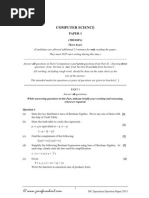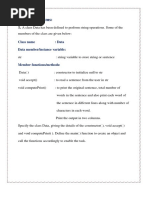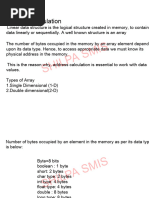ISC Computer Science Question Paper 2016 Solved For Class 12 - A Plus Topper 3
Uploaded by
samm guptaISC Computer Science Question Paper 2016 Solved For Class 12 - A Plus Topper 3
Uploaded by
samm gupta MENU
ISC Computer
Science Question
Paper 2016 Solved for
Class 12
August 28, 2019 by Prasanna
ISC Computer Science
Previous Year Question
Paper 2016 Solved for
Class 12
Maximum Marks: 70
Time allowed: 3 hours
Candidates are allowed additional 15 minutes
for only reading the paper.
They must NOT start writing during this time.
Answer all questions in Part-1 (compulsory)
and six questions from Part – II, choosing two
questions from Section-A, two from Section-B
and two from Section-C.
All working, including rough work, should be
done on the same sheet as the rest of the
answer.
The intended marks for questions or parts of
questions are given in brackets [ ].
Part – I (20 Marks)
Answer all questions
While answering questions in this Part, indicate
brieVy your working and reasoning, wherever
required.
Question 1.
(a) State Involution law and prove it with the help of a
truth table. [1]
(b) Show that X ∨ ~ (Y ∧ X) is a tautology. [1]
(c) Find the dual of [1]
YX + X’ + 1 = 1
(d) Write the maxterm and minterm, when the inputs
are A = 0, B = 1, C = 1 and D = 0. [1]
(e) Draw the logic circuit of a NAND gate using NOR
gates only. [1]
Answer:
Aakash Live NEET
Prepare from safety of home
Choose from a Range Of Live Online Lectures
with convenience of your Home. Join Now!
digital.aakash.ac.in
OPEN
Question 2.
(a) Deane the term fall through the condition with
reference to switch () case. [2]
(b) Convert the following inax expression into postax
form: [2]
A + B / C * (D/E * F)
(c) A matrix A[m] [n] is stored with each element
requiring 4 bytes of storage. If the base address at
A[1] [1] is 1500 and the address at A [4] [5] is 1608,
determine the number of rows of the matrix when the
matrix is stored in Column Major Wise. [2]
(d) From the class declaration given below, state the
nature of the identiaers A, B, C and D: [2]
class A extends B implements C, D
(e) State one advantage and one disadvantage of
using recursion over iteration. [2]
Answer:
(a) Fall through is prevented with a break keyword at
the end of the matching body, which exits execution
of the switch block, but this can cause bugs due to
unintentional fall through if the programmer forgets
to insert break statement.
(b) A + B/C * (D/E * F) = A + B/C (D/EF*)*
= AB/C+ (D/EF*)*
= AB/C + DEF*/*
(c) A [m] [n]
i = 4, B = 1500
j = 5, w = 4
B [i][j] = 1608
Class A is the superclass of B which in turn is the
superclass of subclass C and D
Aakash Live NEET
Easy Installment Options
Choose from a Range Of Live Online Lectures
with convenience of your Home. Join Now!
digital.aakash.ac.in
OPEN
(e) In iteration, the statement is executed repeatedly
using the same memory space which is allocated
once.
In recursion, the statement is executed repeatedly by
invoking the same function within itself and for each
recursive call, a fresh memory is allocated. The
recursive function runs slower as compared to
iteration.
Question 3.
The following function Check() is a part of some
class. What will the function Check() return when the
values of both ‘m’ and ‘n’ is equal to 5? Show the dry
run/working. [5]
int Check (int m, int n)
{
if(n = = 1)
return - m --;
else
return + + m + Check (m, -- n);
}
Answer:
The value of m and n are 5 which is not equal to 1. It
is, for this reason, the arst if block is not executed as
a result it will jump to the else part where the value of
m will be 6 and n will be 4. As m is having Pre
Increment operator so the value of m is changed to 6
and the value of n to 4 as it is the Pre Decrement
operator.
Part – II (50 Marks)
Answer six questions in this part, choosing two
questions from Section-A, two from Section-B and
two from Section-C
Section – A
Answer any two questions
Question 4.
(a) Given the Boolean function F (A, B, C, D) = Σ (1, 3,
5, 7, 8, 9, 10, 11, 14, 15).
(i) Reduce the above expression by using 4-variable
Karnaugh map, showing the various groups (i.e.
octal, quads and pairs). [4]
(ii) Draw the logic gate diagram for the reduced
expression. Assume that the variables and their
complements are available as inputs. [1]
(b) Given the Boolean function:
F (A, B, C, D) = π (4, 6, 7, 10, 11, 12, 14, 15)
(i) Reduce the above expression by using the 4-
variable Karnaugh map, showing the various groups
(i.e., octal, quads and pairs). [4]
(ii) Draw the logic gate diagram for the reduced
expression. Assume that the variables and their
complements are available as inputs. [1]
Answer:
(a) (i) F (A, B, C, D) = Σ (1, 3, 5, 7, 8, 9, 10, 11, 14, 15)
Question 5.
(a) What is a decoder? Draw the logic diagram for a
binary to octal (3 to 8) decoder. [3]
(b) How is a half adder different from a full adder?
Draw the truth table and derive the SUM and CARRY
expression for a full adder. Also, draw the logic
diagram for a full adder. [4]
(c) State whether the following expression is a
Tautology, Contradiction or a Contingency, with the
help of a truth table:
(X=>Z)∨~[(X=>Y)∧(Y=>Z)] [3]
Answer:
(a) A decoder is a circuit which converts the binary
number into equivalent decimal form. In a decoder, if
there are 3 input lines it will be capable of producing
8 distinct output one for each of the states.
Half Adder: It is a logic circuit that adds two bits. It
produces the outputs; SUM and CARRY.
Full Adder: It is a logical circuit that adds three bits. It
produces two outputs; SUM and CARRY
Question 6.
(a) A passenger is allotted a window seat in an
aircraft if he/she satisaes the criteria given below: [5]
The passenger is below 15 years and is
accompanied by an adult.
or
The passenger is a lady and is not accompanied by
an adult.
or
The passenger is not below 15 years but is travelling
for the arst time.
The inputs are:
Inputs
A The passenger is below 15 years age.
The passenger is accompanied by an
C
adult.
L The passenger is a lady.
The passenger is travelling for the
F
arst time.
(In all the above cases 1 indicates yes and 0 indicates
no).
Output: W – Denotes the passenger is allotted a
window seat (1 indicates yes and 0 indicates no)
Draw the truth table for the inputs and outputs given
above and write the SOP expression for W(A, C, L, F).
(b) State the complement properties. Find the
complement of the following Boolean expression
using De Morgan’s law: [3]
AB’ + A’ + BC
(c) Differentiate between Canonical form and
Cardinal form of expression. [2]
Answer:
(a) From the above, we have four inputs and one
output W. The truth table for the given variables is as
shown below:
(b) The complement property says that any value
AND the compliment of that value equals the OR
identity and that any value OR the compliment of that
value equals the OR identity.
(A AND (A’) = 0; A OR (A’) = 1.)
Try yourself by applying De Morgan’s Law.
(c) Any Boolean function that is expressed as a sum
of minterms or as a product of max terms is said to
be in its canonical form. The Boolean function which
is expressed in the form of degree or cellularity or
binary values is referred to as cardinal form.
For example – The following function is in cardinal
form.
F(P, Q, R) = π(1, 3)
The cardinal form has been converted into canonical
form.
F(P, Q, R) = π(1, 3) = 001, 011
= (P + Q + R’). (P + Q’ + R’)
Section – B
Answer any two questions
Each program should be written in such a way
that it clearly depicts the logic of the problem.
This can be achieved by using mnemonic
names and comments in the program.
Flowcharts and Algorithms are not required.
The programs must be written in Java.
Question 7.
A disarium number is a number in which the sum of
the digits to the power of their respective position is
equal to the number itself. [10]
Example: 135 = 11 + 32 + 53
Hence, 135 is a disarium number.
Design a class Disarium to check if a given number is
a disarium number or not. Some of the members of
the class are given below:
Class name: Disarium
Data members/instance variables:
int num: stores the number
int size: stores the size of the number
Methods/Member functions:
Disarium (int nn): parameterized constructor to
initialize the data members n = nn and size = 0
void countDigit(): counts the total number of digits
and assigns it to size
int sumofDigits (int n, int p): returns the sum of the
digits of the number(n) to the power of their
respective positions (p) using recursive technique
void check(): checks whether the number is a
disarium number and displays the result with an
appropriate message
Specify the class Disarium giving the details of the
constructor! ), void countDigit(), int sumofDigits(int,
int) and void check(). Deane the mainO function to
create an object and call the functions accordingly to
enable the task.
Answer:
class Disarium
{
public static void main (String [ ] args) throws IOException
{
BufferedReader br = new BufferedReader (new InputStreamReader) System.in));
System.out.println ("Enter a number");
int n = Integer.parselnt (br.readLine());
int copy = n, d = 0, sum = 0;
String s = Integer.toString (n);
int len = s.length();
while (copy >0)
{
d = copy % 10;
sum = sum + (int) Math.pow (d, len);
len--;
copy = copy/10;
}
if (sum == n)
System, outprintln (“Is a disarium no”);
else
System.out.prinln (“Is not a disarium no”);
}
}
Question 8.
A class Shift contains a two-dimensional integer
array of order (m×n) where the maximum values of
both m and n are 5. Design the class Shift to shuve
the matrix (i.e. the arst row becomes the last, the
second row becomes the arst and so on). The details
of the members of the class are given below: [10]
Class name: Shift
Data member/instance variable:
mat[][]: stores the array element
m: integer to store the number of rows
n: integer to store the number of columns
Member functions/methods:
Shift(int mm, int nn): parameterized constructor to
initialize the data members m=mm and n=nn
void input(): enters the elements of the array
void cyclic(Shift p): enables the matrix of the object
(P) to shift each row upwards in a cyclic manner and
store the resultant matrix in the current object
void display(): displays the matrix elements
Specify the class Shift giving details of the
constructor(), void input(), void cyclic(Shift) and void
display(). Deane the main() function to create an
object and call the methods accordingly to enable the
task of shifting the array elements.
Answer:
import java.io.*;
class Shift
{
intmat[][];
int m;
int n;
public Shift(int mm, int nn){
m = mm;
n = nn;
m = 5;
n = 5;
mat = new int[m][n];
}
public void input()throws IOException {
InputStreamReader input = new InputStreamReader(System.in);
BufferedReader br = new BufferedReader(input);
for(int i = 0; i < m; i++)
for(int j = 0; j < n; j++){
System.out.print("Elements of the matrix: "+i+", "+j+":");
mat[i] [j] = Integer.parseInt(br.readLine());
}
}
public void cyclic(Shift p){
for(int i = 0; i < m; i++)
for(int j = 0; j < n; j++){
if(i == 0)
this.mat[m-1][j] = p.mat[i][j];
else
this.mat[i-1][j] = p.mat[i][j];
You might also like
- ISC 2006 Computer Science Paper 1 TheoryNo ratings yetISC 2006 Computer Science Paper 1 Theory7 pages
- ISC Computer Science - Official Specimen Paper 2013No ratings yetISC Computer Science - Official Specimen Paper 20139 pages
- Isc Class Xii Computer Science Project Java ProgramsNo ratings yetIsc Class Xii Computer Science Project Java Programs77 pages
- ISC Computer Science Practical Questions and Solutions2014 200870% (10)ISC Computer Science Practical Questions and Solutions2014 200821 pages
- Class-Xii Subject:-Computer Science: Chapter-12 Inheritance and PolymorphismNo ratings yetClass-Xii Subject:-Computer Science: Chapter-12 Inheritance and Polymorphism10 pages
- ISC Computer Science Marks Distribution Chart Paper 1 and 283% (6)ISC Computer Science Marks Distribution Chart Paper 1 and 24 pages
- Dps International School: Subject: Computer Applications Topic: File Handling Name: Grade:11 ISC100% (1)Dps International School: Subject: Computer Applications Topic: File Handling Name: Grade:11 ISC7 pages
- Data Structures - Stacks, Queue and Link List (CLASS 12)No ratings yetData Structures - Stacks, Queue and Link List (CLASS 12)2 pages
- Collection of Number Programs Using Recursion (Second Edition)94% (16)Collection of Number Programs Using Recursion (Second Edition)23 pages
- Data File Handling Application Based Questions AnswersNo ratings yetData File Handling Application Based Questions Answers2 pages
- CBSE Class 12 Computer Science SQL QuestionsNo ratings yetCBSE Class 12 Computer Science SQL Questions4 pages
- Computer Science - Introduction To Java ISC Notes100% (3)Computer Science - Introduction To Java ISC Notes10 pages
- Computer Science (ISC) Sample Practice Paper 275% (4)Computer Science (ISC) Sample Practice Paper 29 pages
- ResPaper ICSE Class X Worksheets 2019 Computer Applications (Arrays)100% (3)ResPaper ICSE Class X Worksheets 2019 Computer Applications (Arrays)2 pages
- Project Work Class - 9 Computer Applications: Hint: No. of Share (Annual Dividend 100) / (Nominal Value0% (1)Project Work Class - 9 Computer Applications: Hint: No. of Share (Annual Dividend 100) / (Nominal Value7 pages
- 189Oswaal ISC Class_12, Computer Science_Revision Notes100% (1)189Oswaal ISC Class_12, Computer Science_Revision Notes19 pages
- Collection of String Programs Using Recursion (First Edition)83% (12)Collection of String Programs Using Recursion (First Edition)18 pages
- Computer Science Project For Isc Programming in Blue J: Ishu Verma 12 A Sherwood AcademyNo ratings yetComputer Science Project For Isc Programming in Blue J: Ishu Verma 12 A Sherwood Academy56 pages
- Computer Applications Practice Paper ICSE 10th100% (1)Computer Applications Practice Paper ICSE 10th17 pages
- ISC 2007 Computer Science Paper 1 TheoryNo ratings yetISC 2007 Computer Science Paper 1 Theory6 pages
- Must Prepare Python File Handling MCQ Class 12 For Term 1No ratings yetMust Prepare Python File Handling MCQ Class 12 For Term 148 pages
- ISC 2008 Computer Science Paper 1 TheoryNo ratings yetISC 2008 Computer Science Paper 1 Theory8 pages
- Belsee Aftermarket Tesla Style Screen Android 11No ratings yetBelsee Aftermarket Tesla Style Screen Android 112 pages
- 3 12th Business Maths Question Bank English MediumNo ratings yet3 12th Business Maths Question Bank English Medium109 pages
- ICT11 Course Outline Introduction To CSSNo ratings yetICT11 Course Outline Introduction To CSS2 pages
- Configure A Network Operating System: Introduction To Networks v5.1No ratings yetConfigure A Network Operating System: Introduction To Networks v5.154 pages
- Rebalancing Shared Mobility-On-Demand Systems: A Reinforcement Learning ApproachNo ratings yetRebalancing Shared Mobility-On-Demand Systems: A Reinforcement Learning Approach7 pages
- Random: - Generate Pseudo-Random NumbersNo ratings yetRandom: - Generate Pseudo-Random Numbers10 pages
- 3.deep Learning Based Object Detection and Recognition Framework For The Visually-ImpairedNo ratings yet3.deep Learning Based Object Detection and Recognition Framework For The Visually-Impaired2 pages
- 123819FMM Industry4.0 - Cat21 - Full-Copy1No ratings yet123819FMM Industry4.0 - Cat21 - Full-Copy175 pages
- Supplementary Learning Module For Senior High School LearnersNo ratings yetSupplementary Learning Module For Senior High School Learners17 pages
- UNIT - 2 Two Dimensional Geometric TransformationsNo ratings yetUNIT - 2 Two Dimensional Geometric Transformations69 pages
- Playnetwork Media Player: Installation & User ManualNo ratings yetPlaynetwork Media Player: Installation & User Manual16 pages
- Fundamentals of Computer Networks ECE 478/578No ratings yetFundamentals of Computer Networks ECE 478/57837 pages
- r1.0 Ge-Dsh-73 82 and 82 Poe User ManualNo ratings yetr1.0 Ge-Dsh-73 82 and 82 Poe User Manual179 pages

























































































